Revised 1 March 2022
Accepted 14 October 2022
Available Online 21 November 2022
- DOI
- https://doi.org/10.55060/s.atssh.221107.044
- Keywords
- Crane culture
Multi-level matching
Ceramic products
Generative design - Abstract
Purpose: In order to make product prototype design meet the perceptual cognition and emotional needs of consumers and guide new technologies to intervene in cultural design innovation, a multi-level matching generation system of feature language and form is proposed exploratively from computer image splicing technology.
Methods: Firstly, taking the crane as the research object, this study analyzes the decorative language symbols of the crane on ancient relics, extracts natural morphological features of the crane, and divides the structural levels based on topological structure analysis to establish a database of characteristic language of cranes. Secondly, this study constructs a mapping relationship among the characteristic language of the artefact, aesthetic style and scene expression based on perceptual cognition through perceptual imagery analysis, and establishes an imagery language database. Finally, based on the SURF feature point matching generation mechanism, the imagery style is integrated to complete the final design.
Conclusion: The multi-level matching and generation system of feature language and form is used to effectively meet the perceptual cognition and emotional needs of consumers, match and fuse the biological characteristics of crane with the product feature variables, improve the design efficiency, and provide a reference for ceramic cultural product design.
- Copyright
- © 2022 The Authors. Published by Athena International Publishing B.V.
- Open Access
- This is an open access article distributed under the CC BY-NC 4.0 license (https://creativecommons.org/licenses/by-nc/4.0/).
1. INTRODUCTION
Design, as a creative activity, is a witness and epitome of culture. Design and culture are closely linked. Meanwhile, design changes the way culture is transmitted, carries cultural values and connotations, and has become one of the cores of cultural industrial development. With change of times and technology, design methods are also changing. From the time when the ancestors carve animal symbols on artefacts to the present day when computer technology is used for design, technological interventions in design innovation have brought new possibilities.
In the new context of the times, cultural heritage innovation through technological empowerment has become a new proposition. From a review of the literature, the use of new technologies to extract cultural characteristics for ceramic innovation research has become a new trend. For example, Han Rong et al. analyzed the artistic and aesthetic trends of the Han Dynasty by classifying eared lacquer cups and combining ergonomics and appliance functions. Zhu Shang et al. studied from the perspective of semiotics and constructed a personalized customization system based on the topological primitive theory, which was applied in the creative design of intangible heritage derivatives. However, this method had low user participation. Shi Jie et al. used genetic algorithm to establish a coupling optimization design system to optimize the design of product prototype form, and discussed the feasibility of coupling optimization of product image prototype form in the refinement design of product form. Based on the design characteristics of user preference evaluation, Su Jianning et al. applied basic analysis method, morphological analysis method, orthogonal test, etc., and integrated cultural characteristics into the product modeling, designed the quick cup for the turtle-shaped snake-pattern longevity culture, and effectively improved the user satisfaction of cultural products. According to related literature, to explore design applications with the use of new technologies can help the formation of new design methods, but the integration of cultural feature extraction applications and user preference evaluation research, as well as the use of image technology for multi-dimensional feature matching to generate design, needs to be further developed. This study attempts to explore a multi-level matching generation system of feature language and form from crane culture and user needs. Based on multi-dimensional feature language variables, the system automatically accepts and processes the information to complete the concept of matching generation of ceramic design.
2. ANALYSIS ON THE CULTURAL CHARACTERISTICS OF CRANES
As time progressed, the crane gradually changed from a natural creature to an ideology, becoming an example of the fusion of natural imagery and culture. In terms of semantic expression, the crane is extremely rich in form and ornamentation, with a variety of artistic forms that are handsome and spacious, holy and elegant. As can be seen from the existing historical remains, with the change of dynasties and the change of people's ideology, material pursuit and aesthetic style, the artistic forms of the crane are also diversified and rich, becoming one of the typical cultural and artistic forms. The crane culture in different periods has performed the distinctive mark of the times, the humanistic and artistic style and the spiritual pursuit [1].
2.1. History of the Crane
The crane was already present in people's cultural life during the Neolithic Age, and a pottery jar with painted crane figures was excavated in Linru County, Henan Province, in 1987. Therefore, the crane was regarded as a totemic culture. A crane jade accessory of Shang Dynasty excavated from the tomb of Fuhao in Anyang, Henan, performed a certain shape and form. According to “The Book of Songs” and “Xiaoya · Heming”, “the sound of cranes was heard in the wilderness.” The cranes were used as a metaphor for the wise men of the city who wished to be appointed by the emperor, and they were also referred to as the cranes in later times. The square pot of lotus and crane in the Spring and Autumn Period and the Warring States Period is the earliest existing art work on cranes and represents the highest level of bronze art. The emergence of square pot of lotus and crane marks that cranes gradually enter the vision of artists. Viewing ‘T’ painting on silk of the Western Han Dynasty, unearthed at Mawangdui, there ae five cranes singing with their heads up and two cranes flying with their wings out, marking that cranes begin to move from earth to heaven in people's minds. With the advent of Taoism in the Eastern Han Dynasty, the crane was recorded in the biographies of the immortals and ancient legends, becoming a symbol of immortality. During the Wei, Jin and Northern and Southern Dynasties, Confucianism, Buddhism and Taoism mingled with each other to produce a variety of ideas, and the literati used the crane to express their feelings. During the Tang and Song Dynasties, cranes were respected in poetry, and crane culture entered a new phase of art. During the Ming Dynasty, cranes began to appear in the imperial palace, where they were not only kept but also incorporated into the culture of the palace. During the Qing Dynasty, cranes were used on the robes of first-ranking civil officials and were respected as “first-ranking birds”. Since the Republic of China, with the improvement of environmental awareness and the proposal of the concept of harmonious coexistence between man and the natural environment, the appreciation of cranes has been different from that before, and the crane culture has been further deepened and popularized due to the progress of science and technology [2].
2.2. Crane Pattern
As times change, the expression of crane culture also varies (as shown in Fig. 1). The wares with crane pattern in the Neolithic Age were simple and rough in craftsmanship. Being influenced by primitive totem worship, wares with crane pattern performed symbolic and ritualistic features. Crane patterns were common on bronze vessels during the Spring and Autumn Period and the Warring States Period, and the shapes and iconography slowly became more lifelike. During the Qin and Han Dynasties, the crane motifs developed rapidly, and the carriers with crane patterns became more diverse, with richer shapes and artistic gestures. During the Tang and Song Dynasties, the crane became one of the most popular birds among the literati, and the crane motif was interpreted in a more dynamic and detailed manner. During the Ming and Qing Dynasties, crane motifs were mature, becoming less formal and more decorative and following formal beauty. With the evolution, artistic images of crane have become more mature, with the ethereal and unconventional image of cranes taking hold of people's hearts.
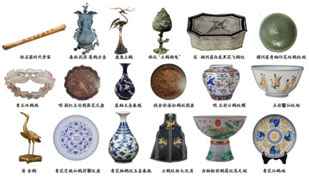
Ancient artefacts of the “crane”.
2.3. Crane Posture
The crane body is well-proportioned, with soft and smooth lines. “S-shaped” curve is extremely attractive and aesthetically pleasing, and the three most common postures are crane standing, crane dancing and crane flying (as shown in Fig. 2). The standing posture of the crane is vivid, varied and energetic. At the same time, the long and slender feet and strong and healthy body would show the strange and unusual temperament, giving people a comfortable and elegant visual impression. According to the “Ode to the Goddess of the Luo River” by Cao Zhi, the tall and thin man stands like a crane stretching out feet and neck, perfectly illustrating the elegance of the crane posture. The crane can sing and dance well. The crane dances with a dynamic posture, its long neck looks at the sky in a bowed shape, its wings stretch out with a noble temperament. The crane body is stretched out and its neck stretches forward as it soars through the sky in a proud and graceful manner. The Chinese image of a crane flying shows the slender characteristics of the crane, with the curves showing the rhythm and the bold use of ink in the painting, which is spontaneous and transparent without being obscure [3].
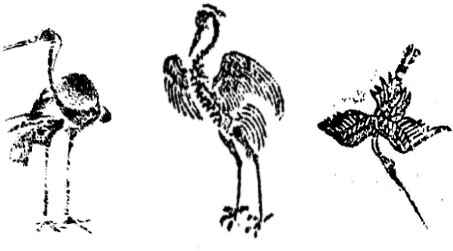
The three postures of the crane.
3. MULTI-LEVEL MATCHING SYSTEM FOR FEATURE LANGUAGE AND FORM
A multi-level matching system is a form in which multiple subsystems are integrated by interaction. In product design, the elements are interdependent and adaptable to each other. By analyzing the material language or mental preferences between the elements of the product form, a matching mechanism is obtained that can metamorphose the imaginative feature language into a complete design.
3.1. Framework for a Multi-Level Matching System of Feature Language and Form
The multi-level matching system of feature language and form consists of four feature variables selectable for users, including the biological feature language of the original material, the artefact feature language, the aesthetic style, and the situational expression (usage scenario), which can be divided in five operational steps, such as receiving, processing, analysis, matching and generation.
Firstly, the topological structure analysis method is used to divide the original material into feature levels, filter the significant features by topological weights, extract corresponding contour lines, and establish the feature language database of original material. Based on perceptual imagery analysis, starting from the intentional feature vocabulary such as artifact feature language, aesthetic style and scene expression, this study analyzes successful cases at home and abroad, collates the contour lines of the imagery vocabulary corresponding to the imagery form, and establishes the imagery language database [4].
Secondly, on the basis of the modeling database, the index relationship between the intention vocabulary and the imagery forms in the database is established. Meanwhile, the imagery forms are selected through the index, and the imagery forms are analyzed and processed by using the surf feature point matching image splicing technology. Also, the intention form features and contour lines are extracted for matching, fusing and stitching the images, and the plan scheme will be output. Finally, the Richter scale is used to evaluate the design of the plan scheme and the best design scheme with distinctive cultural crane characteristics is selected for optimization. The specific framework is shown in Fig. 3.
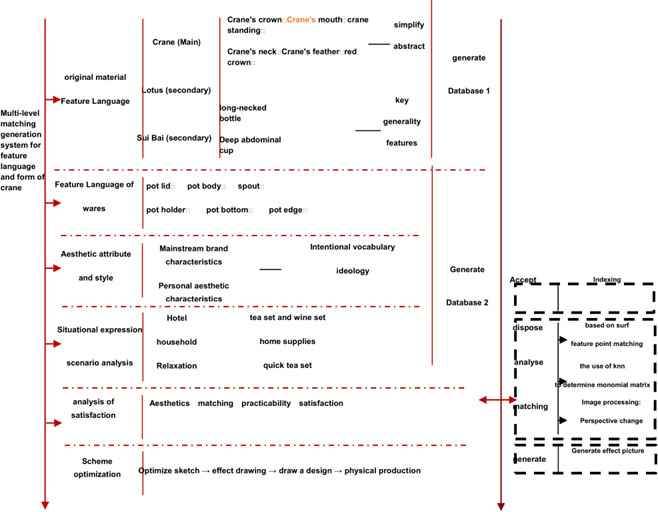
Framework of multi-level matching generation system for feature language and form (drawn by the author).
3.2. Steps of Multi-Level Matching System for Feature Language and Form
The multi-level matching system for feature language and form consists of the following five main steps.
1. Creating a Database
Based on topological structure analysis and perceptual imagery analysis, it is suggested to collate the intention vocabulary, collect the corresponding imagery images, and establish MYSQL database of the collected images. The new database is divided into the feature language database of the original material and the imagery vocabulary database [5].
2. Establishment of Index
It is necessary to establish the indexing relationship between the intentional form and the imagery vocabulary based on the database. Each image will be noted with the imagery feature vocabulary (such as elegance, purity), and the feature index will be established according to the imagery feature vocabulary of each image. The main features extracted include crane features, linguistic features, artefact features, aesthetic styles, scenes of use, etc.
G = {G1, G2, ... , Gn} refers to the set of all database images, F represents the feature vocabulary of the image, and f ∈ F, Gf = f{g|g ∈ G, f ⊆ g} refes to the image for which such a feature vocabulary exists. Based on F and G, it is suggested to create a backward index. The feature vocabulary f is the index element and the corresponding content Gf can be the corresponding image in the database.
3. Feature Point Extraction
Feature point matching is carried out by means of SURF feature point matching methods. With the use of SURF features, the convolution operation of image I(x, y) with Gaussian kernel functions of different scales carried out to establish the scale space. Meanwhile, it is suggested to calculate the Hessian matrix H for the pixel point (x, y) in the image I(x, y) of scale σ.
Gaussian second partial derivative
SURF algorithm is used for fast construction of Hessian matrices in order to speed up the efficiency of operations. The determinant of the approximate Hessian matrix is
Dxx, Dxy and Dyy are the results of the convolution of the pixel point (x, y) with the box filters of different size in the image I(x, y), respectively.
4. Feature Fusion
Euclidean distance is used as a measure of feature point matching. The smaller the distance between two points, the higher the matching rate. The Hessian matrix is first used to remove the mismatched point pairs. When the matrix trace directions of the point pairs are the same, the Euclidean distance can be used as reference data by calculating the Euclidean distance. If the trace directions are different, they can be directly eliminated, and the final resulting feature points are depicted and presented on the image (stitched image) to output the complete solution [6].
5. Multi-Level Matching Optimization Design
Five relevant designers or ceramic experts are invited to make suggestions for the final evaluation dimensions. After summarizing the results, four evaluation dimensions are finally established, such as aesthetics, matching, satisfaction and practicality, which are scored by means of a Richter scale.
4. APPLICATION EXAMPLES
4.1. Crane Feature Language Database
After observing the crane pattern, this study uses the crane as original material for topological analysis and extracts the typical imagery of the crane. As shown in Fig. 4, the crown of the crane is at the second level; at the third level, there are head, torso and legs; at the fourth level. There are mouth, crown, wings, curves, black feet and so on. The recognizable features such as the crane mouth and crown can be expressed in the design process by way of deformation [7].
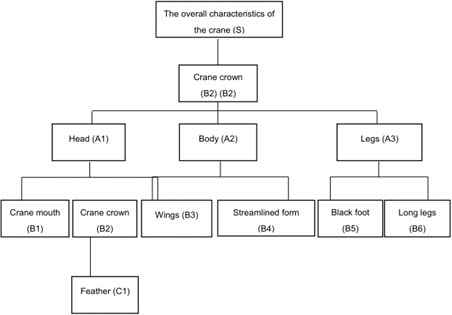
Topology of the crane.
It is suggested to calculate topological weights by means of the topological weights formula:
It is suggested to calculate the topological weights according to the formula, identify the significant features and non-significant features of cranes, and generate a database. And the user can search and select the material features in this system interface.
4.2. Imagery Language Database
4.2.1. Artefactual Feature Language
Ceramic teapot samples are collected from major international competition winners and online shopping platforms and classified according to shape. Ceramic teapots consist of many parts, with different structural characteristics. Therefore, ceramic teapots can be broken down into a variety of separate structures for analysis [9]. The process of selecting the basic shapes of ceramic teapots tried to encompass different forms or shapes of spout, body, handle and lid (as shown in Table 1).
| Structure | Feature Vocabulary |
|---|---|
| Side view of spout | Straight, arc, curve, combination of straight and curve |
| Top view of spout | Straight, curve, combination of straight and curve |
| Side view of pot body | Straight, arc, curve, combination of straight and curve |
| Top view of pot body | Round, polygon, oval |
| Side view of pot handle | Straight, arc, curve, combination of straight and curve |
| Top view of pot handle | Straight, curve, combination of straight and curve |
| Side view of lid | Straight, arc, curve, combination of straight and curve |
| Top view of lid | Round + combination of straight and curve/curve; Polygon + combination of straight and curve/curve; Oval + combination of straight and curve/curve |
Imagery vocabulary on basic shape of ceramic teapots.
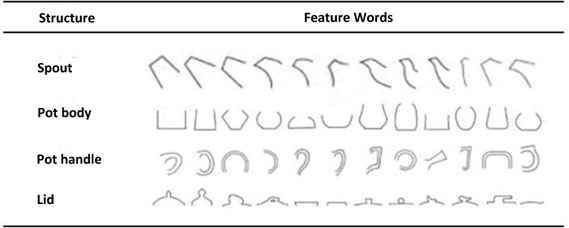
Database of basic shapes of ceramic teapots.
The corresponding imagery forms are collected according to the structural imagery of the teapot shape, the contour lines are extracted, and the shapes are classified and added to the imagery language database, as shown in Fig. 5.
4.2.2. Aesthetic Stylistic Features
A group discussion is used to summarize the vocabulary of teapot characteristics from four perspectives: shape, decoration, temperament and color. The imagery vocabulary collected is collated and classified through analysis and discussion, excluding words with similar meanings or unknown pointers, and the selected words are collated and summarized, as shown in Table 2.
Through the questionnaire method, 20 folk ceramic enthusiasts and ceramic students are invited to conduct a semantic questionnaire survey to select 20 semantic terms from 85 imagery terms that they find most relevant semanteme words, and after collating the results, the eight most frequent terms are derived: pure, modern, antique, solemn, well-shaped, slender, elegant and noble. Using a desktop research approach, the example products are analyzed to collate the characteristics of each imagery vocabulary and collated into a table, as shown in Table 3.
Eight groups of images related to the imagery vocabulary are collected and analyzed to derive the line decoration of the teapot, with the main focus on the side views that show the handle and spout, as shown in Fig. 6, which are collated for addition to the imagery language database.
| Style | Form |
|---|---|
| Shape | Light, elegant, strict, well-proportioned, dignified, magnanimous, full-bodied, well-defined, generous, firm, beautiful. |
| Decoration | Unity, enthusiasm, complexity, splendor, rhythm, contrast, fullness, clarity, simplicity, richness, plain, exaggerated, simple, smooth, handsome, unified, vivid, bold. |
| Temperament | Loyal, gentle, handsome, powerful, tough, brave, treacherous, funny, witty, disgusting, athletic, weird, smooth, upright, spontaneous, upright, elegant, firm, violent, rugged, bold, cool, dignified, pretty, weather, calm, intellectual, serene. |
| Color | Sharp contrast, pure, streamer, clear, complex, vivid, interesting, bold, exaggerated, complex, spiritual, rhythm, virtual, real, soft, simple, gorgeous, noble, fresh, simple, lively. |
Imagery vocabulary on aesthetic style of ceramic teapots.
| Vocabulary on Style | Meaning |
|---|---|
| Pure | Pure refers to giving priority to the conciseness, being simple, elegant and regular with pure color. |
| Modern | Modern image forms are different, mainly being concise, with simple, pure and bold glaze color. |
| Antique | Antique imagery is of vintage style, with its form, glaze and decoration drawing on ancient styles. |
| Solemn | Solemn imagery is elegant and dignified, with a decent form but no fancy decoration. |
| Well-shaped | Well-shaped is reflected in the round contours of the teapot, usually with a large internal space. |
| Slender | Slender image is the opposite of voluptuous, with tall proportions. |
| Elegant | Elegant image is not gaudy, with use of sedate and generous colors, paying attention to proportion. |
| Noble | Noble imagery is ornate, with strong color expressions to achieve a luxurious effect |
Analysis on the imagery vocabulary characteristics of the aesthetic style of ceramic teapots.
4.2.3. Analysis of Application Scenarios
It is feasible to analyze and collate major international brand products and award-winning works of major competitions, collect tea set shapes for each use scenario, exclude similar scenarios and select representative scenarios, finally a total of four groups of scenarios related to the use of tea sets are collected, as shown in Table 4. The contour diagrams of the tea sets in each scene are analyzed and extracted, as shown in Fig. 7, which are collated and added to the imagery language database.
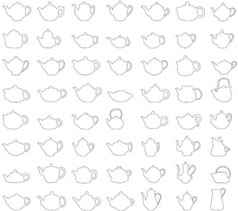
Imagery vocabulary modeling database of ceramic teapots.
| Vocabulary on Scenario | Meaning |
|---|---|
| Teahouse | Due to its location and functionality, the tea set in teahouse is very retro in form and decoration and glaze, with an exquisite workmanship and small size, which is similar to kung fu tea sets. |
| Hotel | The tea set in hotel is the opposite to that in teahouse; the tea set in hotel is generous in appearance and larger in size, which is related to the hotel industry, and the tea needs to be suitable for a larger number of customers to use together. |
| Household | The style of household tea sets is complicated and often matched according to personal preferences. |
| Travel | The quick tea set is maverick, as it needs to be carried around with people, so it is not very large and most of them are of the type that can be folded. |
Scenario analysis on situational expression.
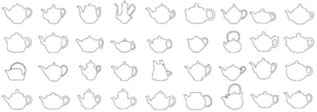
Scenario expression modeling database.
4.3. System Operation
Based on a database, the design scheme can be quickly generated by matching generation system. It is suggested to select the feature-search on the left side of the home page and select “crane” as the main image feature for retrieval. The system displays the search results, as shown in Fig. 8. The most representative images in the crane language, such as the crown, mouth, neck and foot, are selected for this design [10].
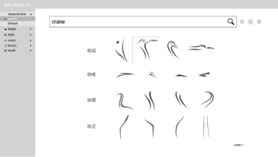
System usage interface 1.
At the end of the selection of feature language of the cranes, the user can choose whether to add secondary feature language according to his preference, such as the imagery of “lotus” and “Sui Bai”. Then, with the use of the same method, it is feasible to select the material language for the features of utensils, aesthetic style, scene expression and other options in the left column. The specific image vocabulary is shown in Table 5. And the final selected feature image is shown in Fig. 9.
| Feature Variables | Basis of Selection | Imagery Vocabulary |
|---|---|---|
| Feature language of original material | Crane culture → square pot of lotus and crane Porcelain with crane pattern → white porcelain |
Crane crown, mouth, neck and foot Lotus leaf, long-necked vase and deep-bellied cup |
| Vessel feature language | Vessels conforming to the curve of the crane pattern | Spout → curve; body → curve Handle → arc; lid → arc |
| Aesthetic style language | Sensual imagery of the crane | Slender, pure, elegant and modern |
| Scene expression language | Household tea sets |
Systematic selection of imagery vocabulary.
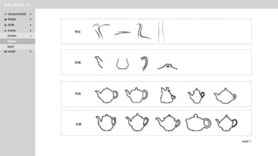
System usage interface 2.
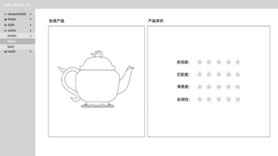
System usage interface 3.
After making sure the selection is correct, it is necessary to click on the NEXT button at the bottom right corner. The system will automatically carry out matching generation and finally generate 4 design solutions. At this time, it is suggested to carry out solution evaluation, as shown in Fig. 10. The matching solutions are evaluated in four dimensions: aesthetics, matching, satisfaction and practicality. 10 designers with industrial and ceramic design backgrounds are invited to evaluate the final matching and fusion results using the Richter scale. The higher the star rating, the better the matching. In the end, the scores of each solution are averaged to produce the final evaluation results shown in Fig. 11 [11].
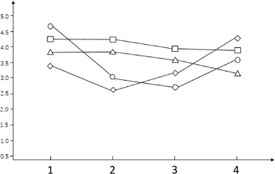
Program evaluation results.
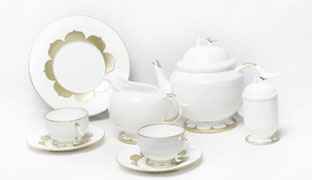
Final design scheme.
The aesthetics, matching, satisfaction and practicality of the matching results are measured together, and the scheme 1 with the highest average of evaluation results is selected for the next-step scheme. In the meantime, some experts in ceramic craftsmanship are contacted to fine-tune the unattainable or unconventional structure without altering its shape, and the physical production is carried out, resulting in the following drawing of the physical effect (as shown in Fig. 12).
5. CONCLUSION
This study conducts product design research from the perspective of technological intervention in innovative design. Starting with the selection of imagery vocabulary and morphology of the feature language, it is feasible to solve the matching problem between databases through index-based pattern matching methods, use the method of image stitching and fusion to achieve fusion matching between imagery forms, propose a multi-level matching system of acceptance, processing, analysis, matching and generation, and conduct feasibility demonstration through design practice cases [12]. With the use of a multi-level matching system to generate designs, it is suggested to follow the fit between users' aesthetic needs and the use of feature language, the product style features are fused with the material language, greatly enhancing the diversity of product forms. When the system is matched and fused, designers can choose the original material language, style features and scenario expressions to generate the final design solution. The method provides a systematic tool that can quickly generate designs, which can be used as a reference for designers.
ACKNOWLEDGMENTS
Project of 2021 Hunan Provincial Social Science Achievement Review Committee (No.: XSP21YBZ114).
Project of 2020 Hunan Provincial Scientific Research Innovation of Postgraduate (No.: CX20200968).
2016 Higher Education Research and Reform Project of Chuanshan College (No.: 2016CY008).
REFERENCES
Cite This Article

TY - CONF AU - Jun Zhou AU - Qi He PY - 2022 DA - 2022/11/21 TI - Application of Multi-Level Matching Design Method Based on Crane Culture BT - Proceedings of the 8th International Conference on Arts, Design and Contemporary Education (ICADCE 2022) PB - Athena Publishing SP - 285 EP - 294 SN - 2949-8937 UR - https://doi.org/10.55060/s.atssh.221107.044 DO - https://doi.org/10.55060/s.atssh.221107.044 ID - Zhou2022 ER -









